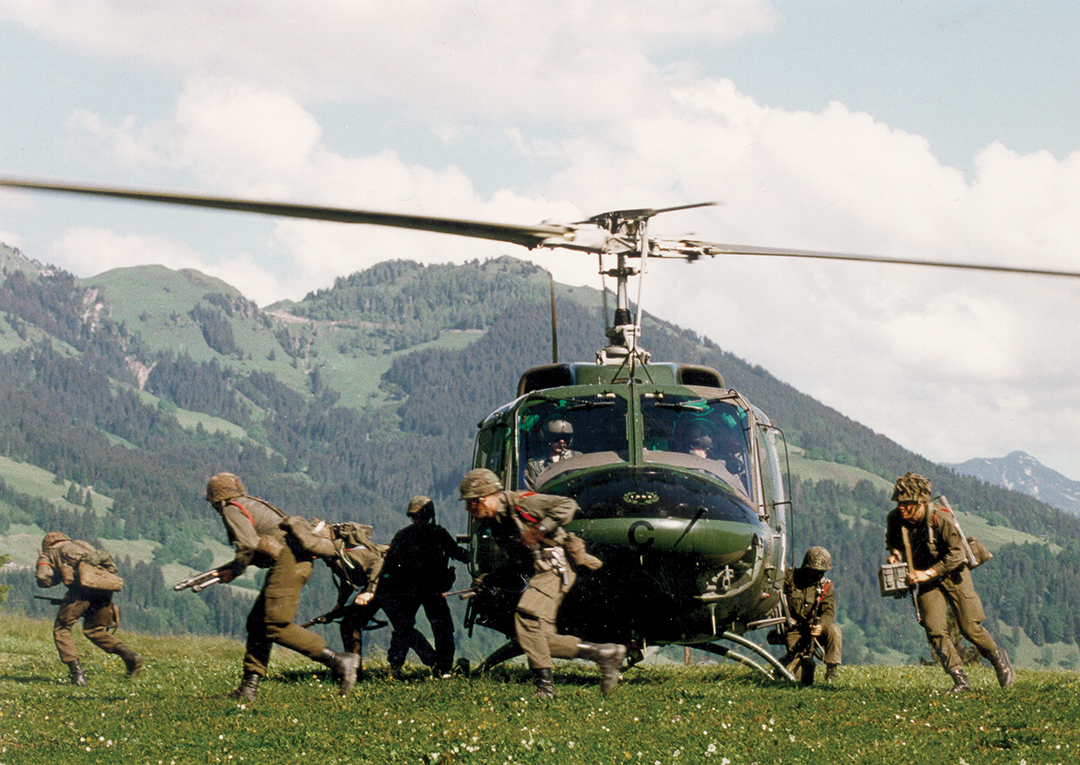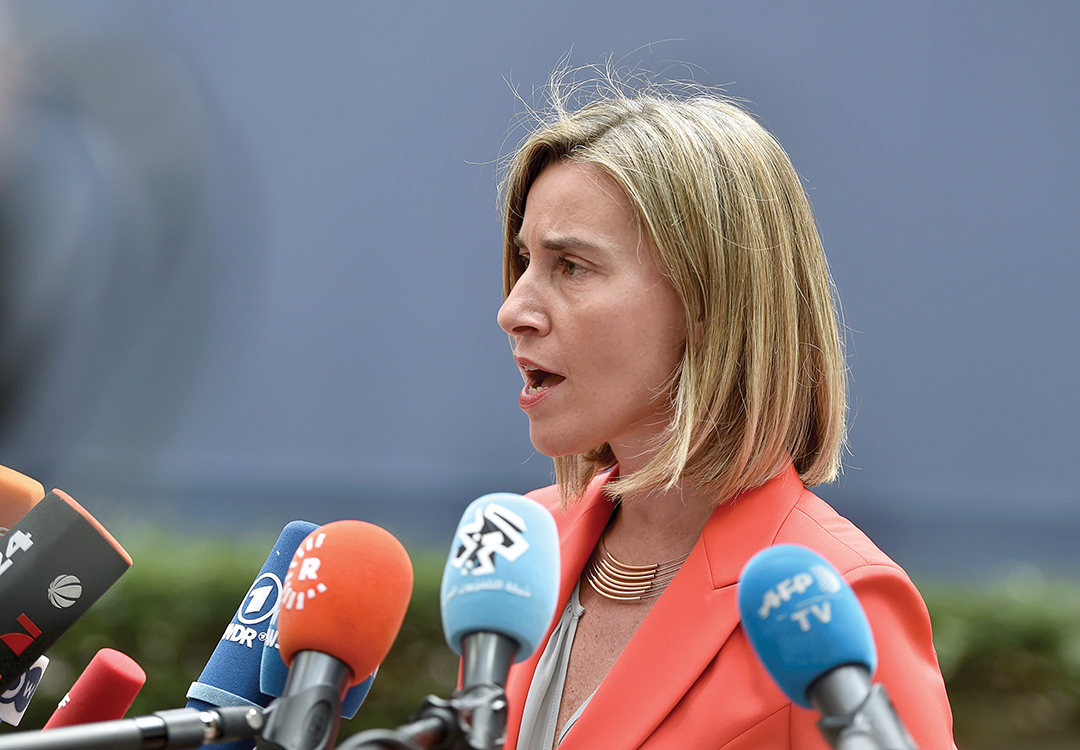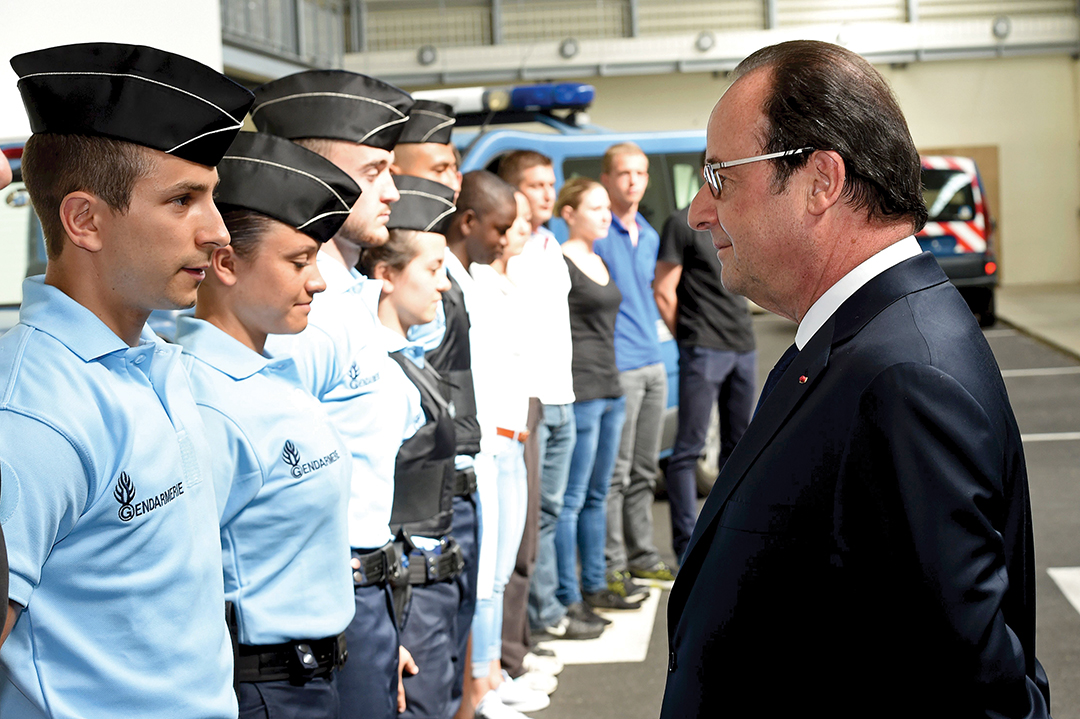Member states should explore using ‘citizen soldiers’ to deal with threats inside Europe
By Alfred C. Lugert, in cooperation with Władysław Bartoszewski, Tuomas Forsberg, Maria Grazia Galantino, Alain Lamballe, Alain Pellegrini, Alexandra Richie and Walter Tancsits
Politicians, the media and academic political experts welcomed the presentation of the European Union Global Strategy (EUGS) on Foreign and Security Policy to the European Council by EU Commission Vice President and High Representative Federica Mogherini on June 28, 2016. The EU needs the policy as much as ever, pointed out Professor Sven Biscop of the Egmont Royal Institute for International Relations in his paper, “The EU Global Strategy: Realpolitik with European Characteristics.”
“First of all, the EUGS introduces a new overall approach to foreign and security policy, which can be read as a correction on the 2003 ‘European Security Strategy (ESS)’ that preceded it,” Biscop said. “The vital interests that the EUGS defines are vital to all Member States: the security of EU citizens and territory. … The EUGS identifies five priorities: (1) the security of the EU itself; (2) the neighborhood; (3) how to deal with war and crisis; (4) stable regional orders across the globe; and (5) effective global governance. … First, there is a strong focus on Europe’s own security (which was much less present in the ESS) and on the neighborhood: We will take responsibility foremost in Europe and its surrounding regions, while pursuing targeted engagement further afield.”
What’s at stake is the credibility of these common internal security efforts with European citizens and the governments of EU member states. A comprehensive study is needed to develop a political concept regarding an EU internal territorial military security and defense system, to be implemented by EU member states, to enhance the Common Security and Defense Policy (CSDP) and the Internal Security Strategy for the European Union. This would establish a more efficient EU-wide internal “zone of equal security” for EU citizens as an essential contribution and insurance for a safe and peaceful Europe.

Austrian Federal Army
Internal EU defense systems
The Council of the EU, in its 2014 Justice and Home Affairs Council Meeting, identifies a number of foreseeable main threats in the field of internal security: serious and organized crime, illegal immigration, trafficking in human beings, drug trafficking, organized property crime, cyber crime and subsequent security challenges, trafficking in arms, terrorism in all its forms (special attention given to the issue of foreign fighters), radicalization leading to violent extremism, crises, and natural and man-made disasters.
It is a list of threats to the internal security of Europe that must be augmented to include risks concerning nuclear infrastructure, water-related infrastructure, dramatic aftereffects and serious collateral damages from terrorists and insurgents, and hybrid threats to homeland security.
The threat from insurgents can be particularly devastating because security forces have to deal with people who fight as if they’re engaged in war, and their numbers and firepower can be comparable or even superior to the capabilities of security forces. Finally, a “hybrid threat” can turn into a challenge to the very existence of a state and will need to be faced by a coordinated national defense effort involving all parts of society.
This could include threats to interfere, block or even destroy complex infrastructure and the daily life of European citizens beyond the limits of expected probability. In short, one must recognize that a worst-case scenario could happen.
Even an optimistic approach has to be realistic and include pragmatic and efficient internal security measures to meet a variety of medium and major threats to the well-being and security of EU citizens. It is a primary and inherent obligation of the EU and its member states to provide efficient, future-oriented and specific preparatory internal security measures, including deployments to counter unexpected threats, according to the December 2014 European Union Council Conclusions.
To counter these threats to EU internal territory, especially in cases where the threats are larger and longer lasting, civilian organizations such as the police, gendarmerie, fire departments, the Red Cross and disaster relief organizations will need substantial support and the assistance of organized and well-structured military reserve forces. The army and civilian security forces of a state can be quickly saturated and overstretched when confronted with an intensified terrorist, insurgent or hybrid threat.
What is required is a malleable, elastic force structure to allow quick expansion and reduction of personnel based on the intensity of the threat. The force must be efficient and financially affordable. These strategic reserve forces for internal/territorial tasks (defensive purposes only) should be structured as well-trained reserve units providing the necessary large manpower of “citizen soldiers.”
In addition to their military training, these reservists can provide their professional civilian expertise and territorial knowledge. The EU can contribute usefully and cost-effectively to the setup and maintenance of an efficient territorial defense organization.
These strategic reserve forces, as an essential part of a comprehensive CSDP and Internal Security Strategy, might be called the EU home guards, territorial defense units or EU national guards. They would be a military force organized at the national and provincial level, tasked with homeland security and defense against major threats to the state.

The role of member states
It is very important that the formation of such internal territorial military defense units/national guards be decided and implemented by all EU member states under EU guidelines to ensure a top-down approach, high-level political engagement and basic coordination. It must be coordinated with the CSDP and the Internal Security Strategy, not individually and separately with divergent national goals.
“Common Threats, Common Answers?” is an important question pointed out by the European Commission in the June 15, 2015, document “In Defence of Europe.” The commission continues: “With violent conflicts at the EU’s doorstep, Europe’s growing exposure to hybrid warfare, cyber terrorism, ‘foreign fighters’ and the blurring distinction between external and internal threats, the European security landscape is increasingly complex to navigate.”
Without a strong EU-coordinated internal security and civil-military defense concept, the EU and its member states can’t provide the necessary comprehensive and efficient “common answer.”
EU ‘national guard’ System
The EU engages military aspects of external security issues by discussing, researching, formulating and shaping a coordinated defense system of national military forces. This coordination could lead to further defense integration, ultimately creating an EU army. European Commission President Jean-Claude Juncker expressed such a wish during a news interview in March 2015.
EU defense concepts focus mainly on preparation and military deployment for external crisis management and/or control of the EU’s external border. Consequently, the need for internal territorial military security and defense was set aside, but not forgotten.
After moving from the European Security and Defence Policy (ESDP) to the CSDP in 1993, the additional need for an internal, territorial and passive aspect of defense was raised in security and defense studies. They pointed out that dealing with asymmetrical threat scenarios requires coordinated EU homeland security, together with public relations and popular support.
In 2001, the Royal Military Academy of Belgium published the study, “Public Opinion and European Defense.” It was a large comparative survey conducted in 15 EU countries. With the consent of the European Commission, questions on this subject were inserted into the Eurobarometer survey of autumn 2000. It also surveyed European opinion on the role of the army. As it turned out, the answers were clear and straightforward: “Defending the country/territory” ranked first with 94 percent, followed by “Helping out the country in case of disaster” at 91 percent.
In 2004, a task force of the Institute for Security Studies of the European Union, chaired by Nicole Gnesotto, published a proposal about European defense. Among the strategic scenarios and respective capacities and EU deficiencies, the task force also focused on homeland defense and suggested creating an EU-style national guard or territorial army.
In 2015, the EU, facing a rapid development of dangerous crises that blurred the distinctions between military and nonmilitary threats and internal and external security, sought to reformulate and reidentify EU interests, objectives and evolving threats.
Parallel to mainstream political discussions, research and planning regarding the external projection of European military forces, an interest in internal, territorial and purely passive defense emerged. On January 21, 2015, the European Parliament moved to adopt the annual report from Mogherini, the EU high representative for foreign affairs and security policy, that reflected this changed political and security environment.
The motion also pointed out that EU security policy has to include protection of European values and enforcement of the political and legal order in Europe, thereby restoring and safeguarding peace and stability. Furthermore the motion prioritizes the “EU’s contribution to the territorial defence of its Member States and the security of its citizens by strengthening its ability to defend itself against the threats facing it.”
Point 18 of the motion “urges the Member States, as a matter of urgency, to step up their ability to contribute to territorial defence” and “stresses that all the Member States must enjoy the same level of security.” Point 21 takes the view “that it is increasingly difficult to separate internal from external security.”
The European Commission Special Eurobarometer for 2015 asked about challenges in Europe and the expected role of various bodies in ensuring internal/national security. The police, the judicial system and the army ranked highest.

Discussion and research
It seems that a comprehensive approach to a CSDP, together with the Internal Security Strategy, should include an adequate internal/territorial defense aspect in addition to the main external concerns of European military defense. Based on various civilian defense efforts such as the establishment of a European Civil Protection Force (for external but possibly also for internal use), in addition to civilian instruments like the police, an EU-coordinated national guard could be established as a strategic reserve in all EU states. It has to be emphasized that such units, staffed by reservist citizen soldiers, provide the necessary professional civilian/military capabilities with close civil-military cooperation.
In a widely publicized address to the two chambers of the French Parliament in November 2015, President François Hollande referred to terrorist attacks and threats in Europe and spoke about the external, out-of-area role of the armed forces, and also of the need to establish a national guard manned by reservists in addition to existing armed forces. He also pointed out that “reservists form a strong link between the nation and the army … a National Guard that is trained and available.”
The strategic reserve concept would enable the EU to establish a more efficient, EU-wide internal zone of equal security and should be set up under common EU guidelines that include partnership and solidarity principles. It would enhance structured cooperation as foreseen by EU declarations regarding security and defense. National participation in establishing the zone is also important for countries that are already part of NATO. A great number of possible threats to internal security can be identified. To counter these threats on EU territory, we need earmarked, organized military reserve forces within this territory.
An EU territorial reserve force staffed by citizen soldiers should be activated only in case of need and would not contradict the establishment of coordinated, integrated EU forces for mainly out-of-area conflict management and peace operations under the EU or NATO. On the contrary, these internal/territorial reserve forces would assist EU member states in handling threats and crises.
Recruitment and training should either be voluntary or based on short but intensive compulsory basic training and refresher training obligations. Part-time EU citizen soldiers, handling internal missions at relatively low cost, provide added civilian and military value for the comprehensive defense of the EU.
Further study
Creation of an EU-wide territorial defense force will require further study. In addition to ongoing and/or planned EU research ventures in the field of “mainstream/external” military issues of the EU CSDP, an in-depth project should be initiated to develop a comprehensive political concept regarding an EU internal defense system.
The development of a comprehensive political concept will require professional expertise in the field of politico-military defense issues, covering a wide spectrum of social sciences (including political science, international relations, economics and social psychology). In conclusion, here are some preliminary topics that such a project should cover:
- The search for peace, civilian-military security concepts and major armed conflicts in Europe since 1990.
- The transition from the ESDP to the CSDP in 1993, and then to the EUGS in 2016.
- Present and future needs for a civil-military homeland defense.
- The enduring questions of citizens’ rights and obligations for homeland defense and the sociological, political and ideological implications.
- The roles and responsibilities of Europe’s political leadership in looking for policy options for a new European security strategy.
- The internal-external security nexus and the need for comprehensive and integrated defense strategies.
- Linking external and internal security dimensions (CSDP and Internal Security Policy).
- The concept of armed forces on demand and future preparedness.
- The status of present day national guard/territorial reserve/militias/coastal defense operations in Europe.
- A detailed model for political discussion, decision-making and legal issues regarding the national guard concept.
- Recruitment and provisioning of individual citizen soldiers — including his or her legal and social status as a part-time soldier — civilian employer support, time of service, training, equipment, armament and pay.
- Interface between regular forces, reserve forces and internal territorial forces, including where these citizen soldiers would be stationed and the areas they would protect.
- Full use of professional civilian expertise, in addition to recruitment of former full-time/professional soldiers or from the general reserve component.
- Public awareness, public relations and public opinion.


Comments are closed.